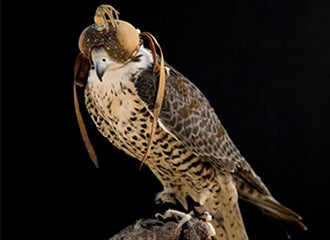
Still Stories
Still Stories
- by Lucchese Bootmaker
- October 22, 2013
- 3 min read
An established editorial photographer in Texas, Bill Sallans took on an unlikely subject when a surprising source of inspiration struck. Already well-versed in capturing people's personalities in their unique environments, Sallans challenged himself to capture the same distinguishing characteristics in... animals.
More specifically, he set out to document falcons trained for hunting in relation to their owners, or falconers.
After one long day outside of Dallas — and with the help of the Texas Hawking Association — Sallans emerged with a series that's taken the art world by storm, thanks to a majestic tone and rare look into a little-known discipline.
For the first installment of "Still Stories," we asked Sallans to share certain moments from the project and who he looks up to in the field.
How did you get hooked on falcons as a subject of a series?
I think falconry is inherently cool. Anything where humans work with animals to hunt or control other animals, I find interesting — whether that's a sheep dog, falcon or purple martin. I first photographed this type of relationship in China years ago, where fishermen were using cormorants to catch fish. When I found out that people were hunting with falcons in Texas, I knew that was what I wanted to photograph next.
You're an established portrait photographer — of people. What was it like venturing into photographing and working with animals?
It was a little bit of a departure for me. For most of the portraits I've done, the human subjects are posed or at least directed. There is a little give and take and a collaboration with the subject. With the falcons, I was trying to capture whatever the birds would give me. Some would respond and turn their head to a whistle, while some were eating their prey.
I had to go with the situation and be ready to capture the moments that just happened. Also all of the falcons were photographed on their falconer's arm, which helped keep that human element and hinted at the falcon-falconer relationship.
Can you explain the hood the falcons are wearing in the photos?
Falcons have extremely good vision. The hoods that the falcons wear keep them calm and from being visually distracted.
Did you find the birds had distinct personalities from one other?
The birds definitely had different personalities and temperaments, and some were more vocal than others. Some were calm and at peace on their handler's arms, other seamed ready and anxious to fly at all times.
How long did this project take?
The entire project was shot in one day. Although it it was a long process to try and get in touch with the right people, it is a relatively small group of people who falcon.
Is there a particular feeling you hope this series will inspire in viewers?
Not really. It's just nice to recognize how beautiful and powerful these birds are. It's incredible to see how fast these birds are in person. When they stoop, they can reach speeds of up to 200 miles-per-hour.
Lastly, who's your photo hero?
I don't know that I have one. He is definitely not a hero, but someone who's work I have always admired is Yousuf Karsh. In my mind, he has some of the defining portraits of many of the people he has photographed; the photos he did of Hemingway and Churchill are two that come to mind. I have a few old copies of Wisdom magazine, which published a lot of his portraits.

